介绍皮影的英语作文
- 格式:doc
- 大小:12.50 KB
- 文档页数:1
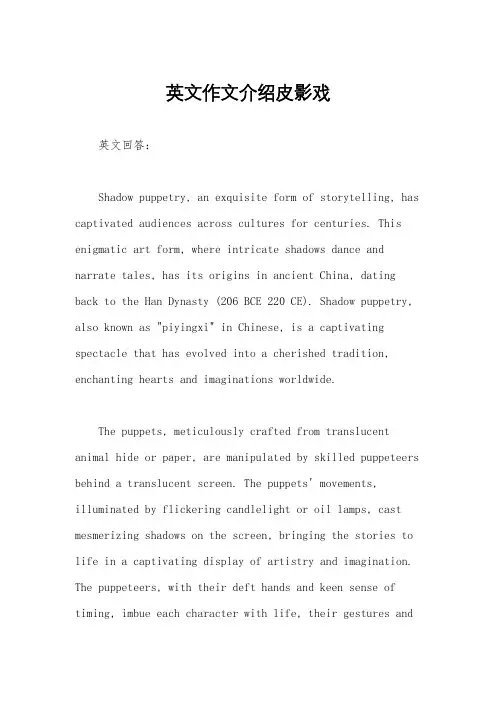
英文作文介绍皮影戏英文回答:Shadow puppetry, an exquisite form of storytelling, has captivated audiences across cultures for centuries. This enigmatic art form, where intricate shadows dance and narrate tales, has its origins in ancient China, dating back to the Han Dynasty (206 BCE 220 CE). Shadow puppetry, also known as "piyingxi" in Chinese, is a captivating spectacle that has evolved into a cherished tradition, enchanting hearts and imaginations worldwide.The puppets, meticulously crafted from translucent animal hide or paper, are manipulated by skilled puppeteers behind a translucent screen. The puppets' movements, illuminated by flickering candlelight or oil lamps, cast mesmerizing shadows on the screen, bringing the stories to life in a captivating display of artistry and imagination. The puppeteers, with their deft hands and keen sense of timing, imbue each character with life, their gestures andmovements gracefully conveying emotions and narratives.Shadow puppetry is a versatile art form, encompassing a vast repertoire of stories, ranging from ancient myths and legends to contemporary tales. Traditional shadow puppet plays often delve into historical events, folktales, and moralistic narratives, while modern adaptations embrace diverse themes, including social issues, cultural heritage, and personal experiences. The versatility of shadowpuppetry allows it to transcend cultural and linguistic barriers, fostering a profound connection with audiences of all ages and backgrounds.In China, where shadow puppetry has a rich history, it has been recognized as an important cultural heritage. UNESCO has inscribed Chinese shadow puppetry on its Representative List of the Intangible Cultural Heritage of Humanity, acknowledging its significance as a livingtradition that embodies cultural identity, community values, and artistic creativity.中文回答:皮影戏,一种精妙的说故事形式,几个世纪以来一直风靡全球各地。
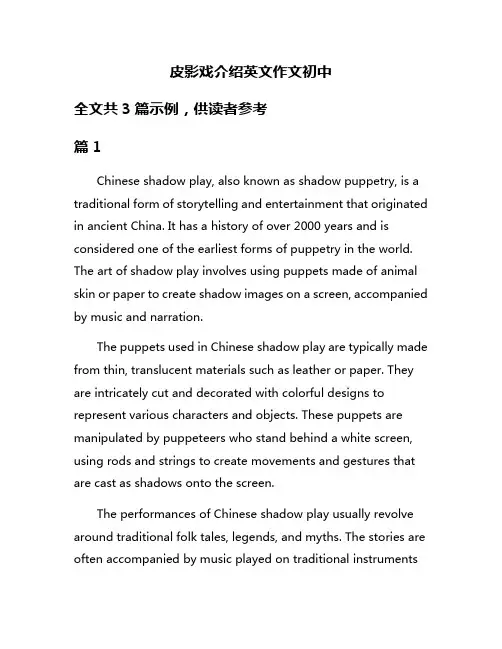
皮影戏介绍英文作文初中全文共3篇示例,供读者参考篇1Chinese shadow play, also known as shadow puppetry, is a traditional form of storytelling and entertainment that originated in ancient China. It has a history of over 2000 years and is considered one of the earliest forms of puppetry in the world. The art of shadow play involves using puppets made of animal skin or paper to create shadow images on a screen, accompanied by music and narration.The puppets used in Chinese shadow play are typically made from thin, translucent materials such as leather or paper. They are intricately cut and decorated with colorful designs to represent various characters and objects. These puppets are manipulated by puppeteers who stand behind a white screen, using rods and strings to create movements and gestures that are cast as shadows onto the screen.The performances of Chinese shadow play usually revolve around traditional folk tales, legends, and myths. The stories are often accompanied by music played on traditional instrumentssuch as drums, gongs, and flutes. The puppeteers also provide voiceovers and sound effects to enhance the storytelling experience.One of the most famous shadow play performances in China is the "Legend of the White Snake," which tells the tale of a powerful and malevolent snake demon who falls in love with a human man. The story is full of drama, romance, and supernatural elements, making it a favorite among audiences of all ages.Chinese shadow play has been recognized by UNESCO as an Intangible Cultural Heritage of Humanity, preserving and promoting this ancient art form for future generations to enjoy. It continues to be performed in traditional theaters, cultural events, and festivals across China and around the world.In conclusion, Chinese shadow play is a unique and captivating art form that has been passed down through generations. It combines storytelling, puppetry, music, and visual effects to create a magical and immersive experience for audiences. Through its rich history and cultural significance, Chinese shadow play remains a cherished part of China's cultural heritage.篇2Introduction to Shadow PlayShadow play, also known as shadow puppetry, is a traditional form of puppetry that has been performed in various cultures around the world for centuries. It is believed to have originated in China during the Han Dynasty more than 2,000 years ago. The art form involves manipulating flat, opaque figures made of leather or paper against a translucent screen to create shadows that tell a story.In China, shadow play is called "pi ying xi" (皮影戏), with "pi" meaning leather and "ying" meaning shadow. The figures used in Chinese shadow play are often made from animal hides, which are intricately cut and painted with vibrant colors. These figures are then mounted on bamboo sticks and manipulated by puppeteers behind a backlit screen.The stories told in Chinese shadow play are usually based on traditional folklore, myths, and legends. The most popular tales include the legend of the Monkey King, the story of the cowherd and the weaver girl, and the adventures of the Eight Immortals. The performances are accompanied by traditional music, singing, and narration to enhance the audience's immersion in the story.Shadow play has spread to other parts of Asia, including Indonesia, India, Malaysia, and Thailand, where it has evolved to incorporate local customs and traditions. Each culture has its own unique style of shadow play, with distinct techniques, figures, and storytelling conventions.In recent years, shadow play has seen a resurgence in popularity as a form of cultural heritage preservation and artistic expression. Many contemporary artists and performers are experimenting with new technologies and storytelling techniques to bring this ancient art form to a modern audience.In conclusion, shadow play is a captivating and enchanting form of puppetry that continues to fascinate audiences around the world. Its rich cultural history, intricate craftsmanship, and timeless stories make it a cherished art form that will continue to endure for generations to come.篇3The Introduction of Shadow PlayShadow play, also known as shadow puppetry, is an ancient form of storytelling and entertainment that dates back to over 2,000 years ago in China. It involves manipulating translucentpuppets made of leather or other materials behind a backlit screen to create dynamic and engaging visual narratives.The puppets used in shadow play are typically intricately designed and crafted, with joints that allow for articulation and movement. These puppets are placed between a source of light and a screen, which can be made of paper, fabric, or other materials that allow light to pass through but are opaque enough to create shadows.The puppeteers, who are skilled in the art of shadow play, stand behind the screen and manipulate the puppets using rods and strings to create a variety of movements and gestures. By moving the puppets closer to or further away from the light source, the puppeteers can control the size of the shadows and create a sense of depth and perspective in the performance.Shadow play performances are often accompanied by music, singing, and narration to enhance the storytelling experience. The stories depicted in shadow play performances can range from traditional folk tales and legends to contemporary adaptations of popular stories and myths.One of the most famous examples of shadow play is the Chinese tradition of shadow puppetry, which has been passed down through generations and continues to be a beloved formof entertainment in many parts of China and other countries in Asia. In addition to its cultural significance, shadow play also serves as a valuable educational tool for teaching history, morality, and cultural values to audiences of all ages.In recent years, shadow play has experienced a resurgence in popularity as a form of visual arts and entertainment. Many artists and performers around the world are innovating new ways to incorporate shadow play techniques into modern theatrical productions, films, and multimedia installations.Overall, shadow play is a timeless and captivating art form that continues to inspire and delight audiences with its creative storytelling and dazzling visual effects. Whether experienced in a traditional village setting or a contemporary theater, shadow play is sure to leave a lasting impression on all who witness its magic.。
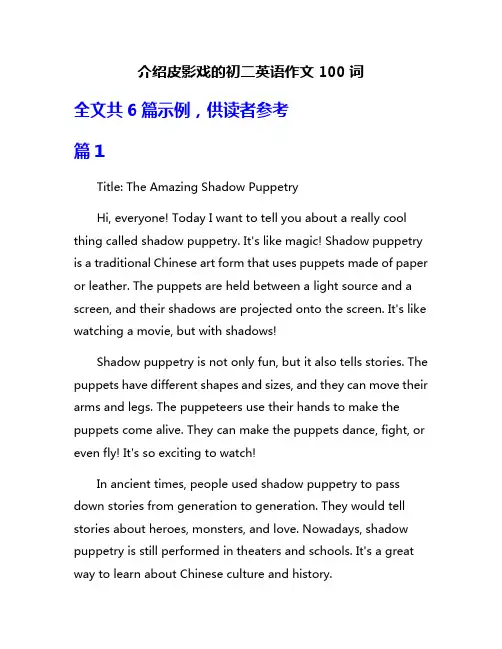
介绍皮影戏的初二英语作文100词全文共6篇示例,供读者参考篇1Title: The Amazing Shadow PuppetryHi, everyone! Today I want to tell you about a really cool thing called shadow puppetry. It's like magic! Shadow puppetry is a traditional Chinese art form that uses puppets made of paper or leather. The puppets are held between a light source and a screen, and their shadows are projected onto the screen. It's like watching a movie, but with shadows!Shadow puppetry is not only fun, but it also tells stories. The puppets have different shapes and sizes, and they can move their arms and legs. The puppeteers use their hands to make the puppets come alive. They can make the puppets dance, fight, or even fly! It's so exciting to watch!In ancient times, people used shadow puppetry to pass down stories from generation to generation. They would tell stories about heroes, monsters, and love. Nowadays, shadow puppetry is still performed in theaters and schools. It's a great way to learn about Chinese culture and history.I remember when I went to see a shadow puppetry show with my family. We sat in a dark room, and suddenly, the screen lit up with beautiful colors. The puppets danced and told a story about a brave warrior who saved his village from a dragon. It was like a dream!I also had the chance to try making my own shadow puppets. It was so much fun! I cut out shapes from black paper and attached them to sticks. Then, I held them in front of a lamp and made different movements. I created my own little puppet show at home!Shadow puppetry is a treasure of Chinese culture. It's a unique and wonderful art form that brings stories to life through shadows. If you ever get a chance to see a shadow puppetry show, don't miss it! You'll be amazed by the magic of shadows!That's all for now. I hope you enjoyed learning about shadow puppetry. Bye-bye!篇2Shadow Puppetry: An Ancient Art Form Brought to LifeHi everyone! My name is Alex, and I'm a student in 8th grade. Today, I want to tell you all about something really cool that Irecently learned about - shadow puppetry! It's a super old art form that has been around for centuries, and it's honestly just amazing.So what exactly is shadow puppetry? Basically, it involves flat figures made of leather or paper that are held up behind a lighted screen or curtain. As the puppets are moved around, their shadows are cast onto the screen, creating the illusion of moving characters and stories. Pretty neat, right?The origins of shadow puppetry can be traced way back to ancient times in various parts of the world like China, India, Turkey, and Indonesia. Each region developed its own unique styles and traditions surrounding this art form.In China, shadow puppetry has a really long history dating back to the Han Dynasty over 2000 years ago! The puppets are made of thin, transparent leather and are operated using rods or strings from behind the screen. The shows often depict folk tales, legends, and even historical events. So cool to think that people have been enjoying this for so many centuries!One of the most famous shadow puppet traditions is found in the Indonesian islands of Java and Bali. Their puppets are intricately carved out of buffalo hide and have those iconic monster-like shapes. The performances include gamelan music,singing, and narration as the puppets act out classic stories from Hindu epics. I've seen videos of Balinese shadow plays, and they are just mesmerizing to watch!Turkey has its own shadow theatre called Karagöz that is over 700 years old. The main characters are the foolish Karagöz and the educated Hacivat, who engage in hilarious conversations full of witty jokes and satire. Watching a Karagöz show must be an absolute blast!India has a few different regional shadow puppet styles as well. In states like Karnataka and Andhra Pradesh, the puppets are made of thin, opaque leather and depict mythological tales from Hindu texts. In other areas like Maharashtra, the puppets are larger figures made of burnt, opaque leather and portray folk stories. No matter the style, shadow puppetry has been an integral part of Indian culture for a very long time.Honestly, learning about all these amazing shadow puppet traditions from across the globe has made me appreciate this ancient art form so much more. The level of skill required to manipulate the puppets and breathe life into each character is just astounding to me. Not to mention the beautiful puppet designs that have been perfected over hundreds and hundreds of years.What I find really fascinating is how shadow puppetry has managed to survive and thrive in the modern age of movies, TV shows, and video games providing endless entertainment. There's just something special and magical about watching these intricate leather puppets come alive through masterful technique and ancient storytelling. It connects you to centuries of culture and tradition in such a unique way.While shadow puppetry may not be as mainstream today, there are still many artists and theatre troupes all over the world dedicated to preserving and promoting this incredible art. Festivals and workshops are held to pass down skills to new generations and expose more people to the beauty of shadow plays. Even museums have permanent shadow puppet collections and exhibits.I feel really lucky to have learned about the rich heritage of shadow puppetry. It has opened my eyes to the amazing diversity of art and traditions around the world. Who knows, maybe I'll even try my hand at making some shadow puppets of my own one day! If you ever get the chance to experience a live shadow puppet performance, I highly recommend going. It's an age-old art form that is truly captivating.篇3Title: Shadow PuppetryShadow puppetry is a traditional Chinese art form that has been enjoyed for centuries. It uses beautifully designed puppets made of leather to tell stories. The puppets are held up against a screen, and a light shines from behind, creating shadows for the audience to see.I love watching shadow puppetry because it's like magic! The puppeteers use their hands to make the puppets move and speak. They can make the puppets dance, fight, and even fly. It's amazing how they bring the stories to life.One of my favorite stories is about a brave hero who saves the village from a fierce dragon. The puppets are so detailed and colorful, and the music adds to the excitement. It's like watching a movie, but with shadows!Shadow puppetry is not only entertaining, but it also teaches us about Chinese culture and history. Many of the stories are based on ancient legends and folklore. It's a great way to learn and have fun at the same time.If you ever get a chance to watch a shadow puppetry show, I highly recommend it. You will be amazed by the skill andcreativity of the puppeteers. It's a unique art form that deserves to be celebrated and preserved.In conclusion, shadow puppetry is a fascinating art form that uses puppets, light, and shadows to tell stories. It's a fun and educational experience for people of all ages. Let's continue to cherish and support this wonderful tradition!Word Count: 100 words篇4当然可以!下面是一篇关于皮影戏的初二英语作文,使用小学生的语言风格,长度约为100词:Title: The Amazing Shadow PlayHi everyone! Today, I want to tell you about a really cool traditional Chinese art form called Shadow Play, or as we call it, "皮影戏" (pí yǐng xì). It's super interesting!Shadow Play is like a puppet show, but with shadows! The performers use flat puppets made of leather. They hold them in front of a bright light, and the shadows are projected onto a white screen. It's like magic!The puppets represent different characters, like heroes, villains, and animals. The performers move the puppets behindthe screen, and we see their shadows. They can make the puppets walk, dance, and even fight! It's so exciting to watch.The stories in Shadow Play are often based on famous legends and folktales. There are stories about brave warriors, clever monkeys, and beautiful princesses. The puppeteers use their voices to bring the characters to life, and they also use musical instruments like drums and flutes.Shadow Play has a long history in China, dating back over 2,000 years. It's not only entertaining but also a way to preserve our cultural heritage. It's like stepping into a world of ancient tales and traditions.I remember the first time I watched a Shadow Play performance. I was amazed by the colorful shadows and the incredible skills of the puppeteers. It felt like the puppets were real!If you ever get a chance to see a Shadow Play, don't miss it! It's a unique and wonderful experience. You'll be captivated by the beautiful shadows and the enchanting stories.That's all for now. I hope you enjoyed learning about Shadow Play. It's one of my favorite traditional Chinese art forms. Bye!Word count: 195 words希望这篇文章能满足你的要求!如果你有其他问题,欢迎继续提问。

介绍中国皮影戏的英语作文China has a long history of traditional folk art, one of which is the art of shadow puppetry, also known as "pi ying xi" in Chinese. It is said that the art of shadow puppetry can be traced back to the Han Dynasty (206 BC - 220 AD).中国有着悠久的传统民间艺术,其中之一就是皮影戏,又称“皮影戏”或“皮戏”。
据说,皮影戏的艺术可以追溯到汉代(公元前206年-公元220年)。
In a shadow puppet performance, figures made of leather are manipulated behind a translucent screen to create the illusion of moving figures. The puppeteers use rods to control the movements of the figures, while a narratortells the story and musicians provide a musical accompaniment.在皮影戏表演中,由皮革制成的人物在半透明的屏幕后面操纵,营造出移动人物的幻觉。
木偶师使用杆子控制人物的动作,而解说员讲述故事,音乐家提供音乐伴奏。
The stories told in shadow puppet performances are often based on Chinese folklore and history, such as the legend of the Monkey King or the story of the Three Kingdoms.These stories are often filled with action, adventure, and moral lessons.皮影戏表演中讲述的故事通常基于中国的民间传说和历史,例如《西游记》或《三国演义》的故事。
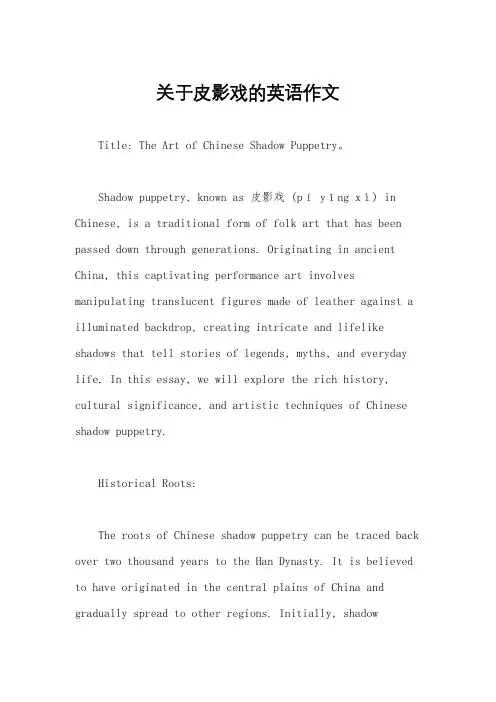
关于皮影戏的英语作文Title: The Art of Chinese Shadow Puppetry。
Shadow puppetry, known as 皮影戏(pí yǐng xì) in Chinese, is a traditional form of folk art that has been passed down through generations. Originating in ancient China, this captivating performance art involves manipulating translucent figures made of leather against a illuminated backdrop, creating intricate and lifelike shadows that tell stories of legends, myths, and everyday life. In this essay, we will explore the rich history, cultural significance, and artistic techniques of Chinese shadow puppetry.Historical Roots:The roots of Chinese shadow puppetry can be traced back over two thousand years to the Han Dynasty. It is believed to have originated in the central plains of China and gradually spread to other regions. Initially, shadowpuppetry was performed for religious rituals and entertainment purposes. Over time, it evolved into a sophisticated art form with its own distinct styles and regional variations.Cultural Significance:Chinese shadow puppetry holds significant cultural value as it reflects the customs, beliefs, and artistic achievements of the Chinese people. It serves as a means of preserving and transmitting traditional stories, morality tales, and historical events from one generation to the next. Moreover, shadow puppetry plays a role in various celebrations, such as weddings, festivals, and religious ceremonies, adding to the cultural richness of Chinese society.Artistic Techniques:The creation of Chinese shadow puppets requires meticulous craftsmanship and artistic skill. Typically, the puppets are made from thin, translucent leather, which iscarved, painted, and perforated to create intricate details. Each puppet represents a specific character, ranging from heroes and villains to animals and mythical creatures. The puppeteers manipulate these figures using rods and strings, bringing them to life on the screen with precise movements and gestures.Performance and Storytelling:A Chinese shadow puppetry performance typically takes place in a darkened room with a white screen or cloth serving as the backdrop. Behind the screen, the puppeteers stand or sit, hidden from view, while the illuminatedfigures cast their shadows onto the screen. Accompanied by traditional music, narration, and dialogue, the puppeteers skillfully manipulate the puppets to enact scenes from folklore, mythology, or historical epics. Through their movements and expressions, the puppets convey emotions, conflicts, and resolutions, captivating the audience with their storytelling prowess.Challenges and Revival:Despite its long history and cultural significance, Chinese shadow puppetry has faced challenges in the modern era. With the advent of television, film, and digital entertainment, traditional art forms like shadow puppetry have struggled to compete for audience attention. Additionally, the decline of rural communities, where shadow puppetry was once prevalent, has further threatened its survival.However, in recent years, there has been a renewed interest in preserving and revitalizing Chinese shadow puppetry. Cultural organizations, museums, and individual artists have launched initiatives to promote awareness, education, and appreciation of this ancient art form. Workshops, performances, and exhibitions have been organized to introduce shadow puppetry to new audiences and inspire future generations of artists and enthusiasts.Conclusion:In conclusion, Chinese shadow puppetry stands as atestament to the creativity, ingenuity, and cultural heritage of the Chinese people. Through its intricate craftsmanship, captivating performances, and timeless stories, shadow puppetry continues to enchant audiences around the world. As efforts to preserve and revive this ancient art form persist, we can hope that the shadows will dance on for generations to come, keeping alive the spirit of Chinese tradition and storytelling.。
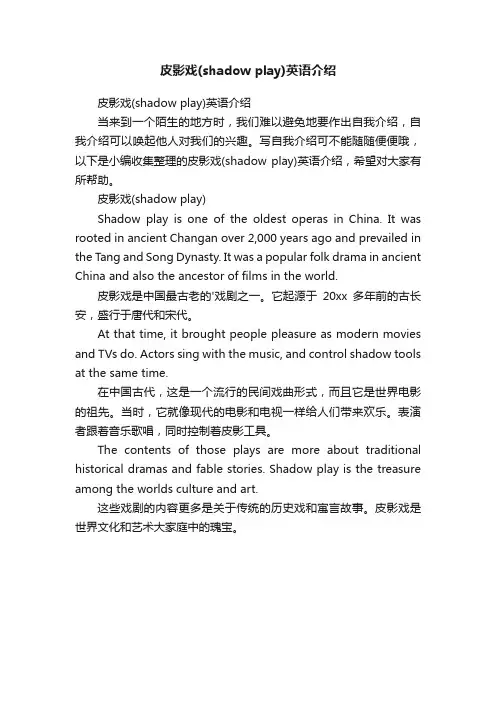
皮影戏(shadow play)英语介绍皮影戏(shadow play)英语介绍当来到一个陌生的地方时,我们难以避免地要作出自我介绍,自我介绍可以唤起他人对我们的兴趣。
写自我介绍可不能随随便便哦,以下是小编收集整理的皮影戏(shadow play)英语介绍,希望对大家有所帮助。
皮影戏(shadow play)Shadow play is one of the oldest operas in China. It was rooted in ancient Changan over 2,000 years ago and prevailed in the Tang and Song Dynasty. It was a popular folk drama in ancient China and also the ancestor of films in the world.皮影戏是中国最古老的'戏剧之一。
它起源于20xx多年前的古长安,盛行于唐代和宋代。
At that time, it brought people pleasure as modern movies and TVs do. Actors sing with the music, and control shadow tools at the same time.在中国古代,这是一个流行的民间戏曲形式,而且它是世界电影的祖先。
当时,它就像现代的电影和电视一样给人们带来欢乐。
表演者跟着音乐歌唱,同时控制着皮影工具。
The contents of those plays are more about traditional historical dramas and fable stories. Shadow play is the treasure among the worlds culture and art.这些戏剧的内容更多是关于传统的历史戏和寓言故事。
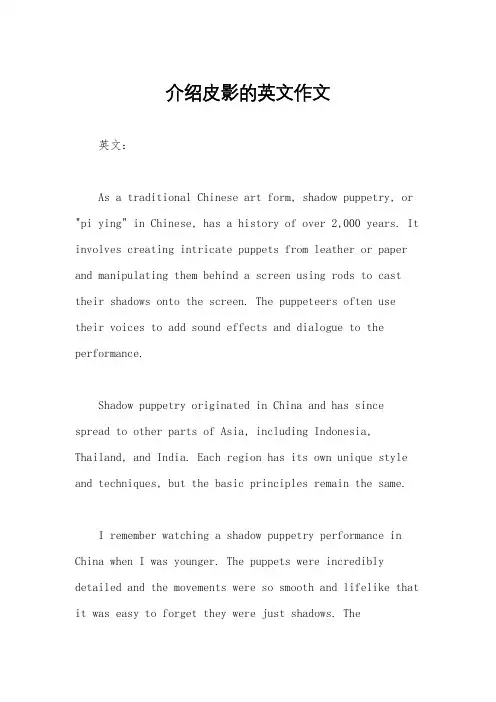
介绍皮影的英文作文英文:As a traditional Chinese art form, shadow puppetry, or "pi ying" in Chinese, has a history of over 2,000 years. It involves creating intricate puppets from leather or paper and manipulating them behind a screen using rods to cast their shadows onto the screen. The puppeteers often use their voices to add sound effects and dialogue to the performance.Shadow puppetry originated in China and has since spread to other parts of Asia, including Indonesia, Thailand, and India. Each region has its own unique style and techniques, but the basic principles remain the same.I remember watching a shadow puppetry performance in China when I was younger. The puppets were incredibly detailed and the movements were so smooth and lifelike that it was easy to forget they were just shadows. Thepuppeteers were also very skilled, seamlessly transitioning between different characters and adding their own flair to the performance.中文:作为一种传统的中国艺术形式,皮影艺术已有超过2,000年的历史。
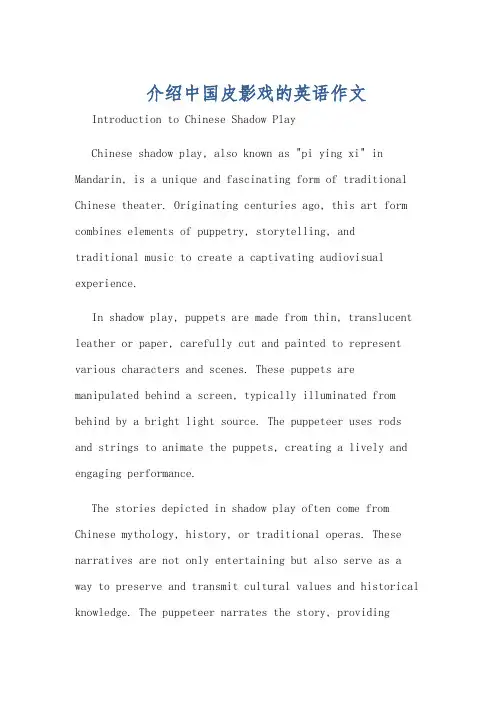
介绍中国皮影戏的英语作文Introduction to Chinese Shadow PlayChinese shadow play, also known as "pi ying xi" in Mandarin, is a unique and fascinating form of traditional Chinese theater. Originating centuries ago, this art form combines elements of puppetry, storytelling, andtraditional music to create a captivating audiovisual experience.In shadow play, puppets are made from thin, translucent leather or paper, carefully cut and painted to represent various characters and scenes. These puppets are manipulated behind a screen, typically illuminated from behind by a bright light source. The puppeteer uses rods and strings to animate the puppets, creating a lively and engaging performance.The stories depicted in shadow play often come from Chinese mythology, history, or traditional operas. These narratives are not only entertaining but also serve as a way to preserve and transmit cultural values and historical knowledge. The puppeteer narrates the story, providingvoice-over commentary and sound effects, while traditional instruments such as drums, gongs, and flutes accompany the action on screen.One of the most enchanting aspects of shadow play is its ability to create an illusion of depth and movement. The puppeteer skillfully manipulates the puppets, creating the illusion of walking, running, fighting, and even flying. The use of light and shadow adds to the magic, casting intricate silhouettes on the screen that captivate the audience's imagination.Shadow play has been a beloved form of entertainment in China for generations. It is not only a source of fun and amusement but also a powerful medium for cultural expression and education. Today, shadow play remains a vibrant art form, enjoyed by people of all ages, and it continues to evolve and adapt to modern audiences.中国皮影戏介绍中国皮影戏,在普通话中也被称为“皮影戏”,是一种独特而迷人的中国传统戏剧形式。
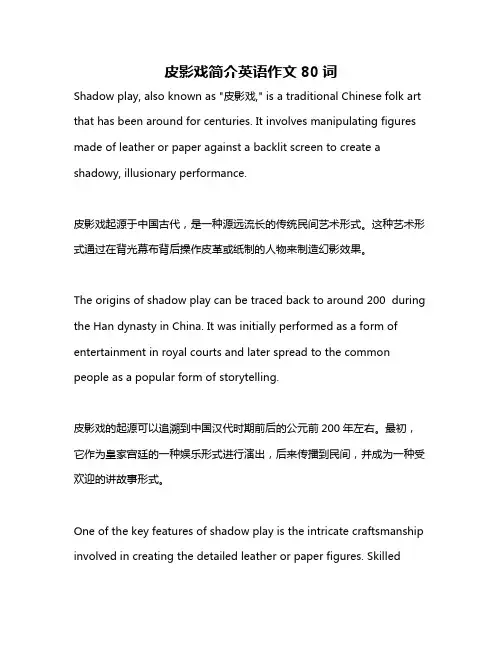
皮影戏简介英语作文80词Shadow play, also known as "皮影戏," is a traditional Chinese folk art that has been around for centuries. It involves manipulating figures made of leather or paper against a backlit screen to create a shadowy, illusionary performance.皮影戏起源于中国古代,是一种源远流长的传统民间艺术形式。
这种艺术形式通过在背光幕布背后操作皮革或纸制的人物来制造幻影效果。
The origins of shadow play can be traced back to around 200 during the Han dynasty in China. It was initially performed as a form of entertainment in royal courts and later spread to the common people as a popular form of storytelling.皮影戏的起源可以追溯到中国汉代时期前后的公元前200年左右。
最初,它作为皇家宫廷的一种娱乐形式进行演出,后来传播到民间,并成为一种受欢迎的讲故事形式。
One of the key features of shadow play is the intricate craftsmanship involved in creating the detailed leather or paper figures. Skilledartisans meticulously cut, carve, and paint each figure to bring them to life on the screen.皮影戏的一个重要特点是制作详细的皮革或纸制人物所涉及的复杂工艺。
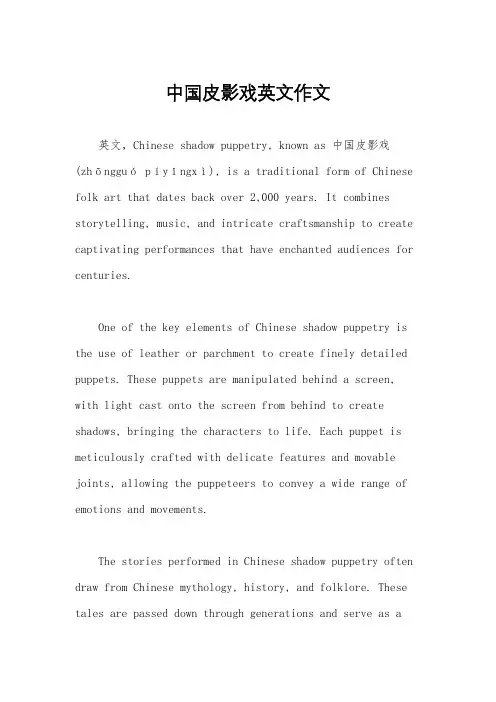
中国皮影戏英文作文英文,Chinese shadow puppetry, known as 中国皮影戏(zhōngguó píyǐngxì), is a traditional form of Chinese folk art that dates back over 2,000 years. It combines storytelling, music, and intricate craftsmanship to create captivating performances that have enchanted audiences for centuries.One of the key elements of Chinese shadow puppetry is the use of leather or parchment to create finely detailed puppets. These puppets are manipulated behind a screen, with light cast onto the screen from behind to create shadows, bringing the characters to life. Each puppet is meticulously crafted with delicate features and movable joints, allowing the puppeteers to convey a wide range of emotions and movements.The stories performed in Chinese shadow puppetry often draw from Chinese mythology, history, and folklore. These tales are passed down through generations and serve as areflection of Chinese culture and values. From epic battles between mythical creatures to heartwarming tales of love and friendship, the stories told through shadow puppetry resonate with audiences of all ages.One of the most famous stories in Chinese shadow puppetry is "The Legend of the White Snake" (白蛇传báishé zhuàn), which tells the story of a white snake spirit who falls in love with a human man. Their forbidden love leads to a series of trials and tribulations, ultimately testing the strength of their bond. Through the use of shadow puppets, audiences are transported into a world of magic and romance, experiencing the timeless tale in a visually stunning and immersive way.In addition to entertaining audiences, Chinese shadow puppetry also plays an important role in preservingcultural heritage. Many puppeteers undergo years oftraining to master the art form, ensuring that these ancient techniques are passed down to future generations. Festivals and performances celebrating Chinese shadow puppetry can be found throughout China, keeping thistraditional art form alive and thriving.Overall, Chinese shadow puppetry is a unique and enchanting form of storytelling that continues to captivate audiences around the world. Its combination of intricate craftsmanship, rich storytelling, and cultural significance make it a cherished part of Chinese heritage.中文,中国的皮影戏是一种源远流长的传统民间艺术形式,可以追溯到2000多年前。
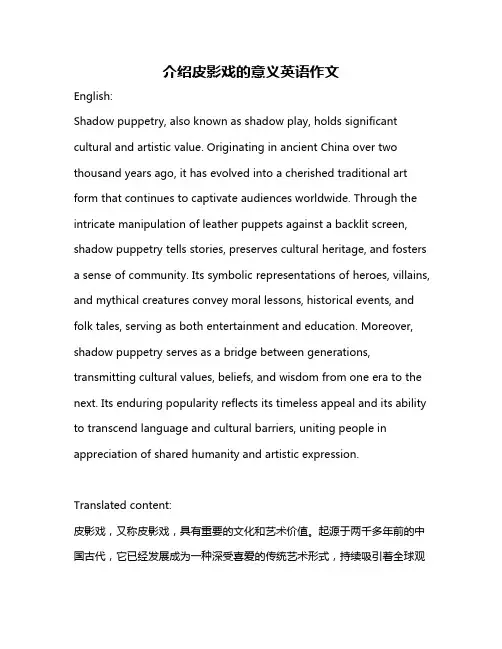
介绍皮影戏的意义英语作文English:Shadow puppetry, also known as shadow play, holds significant cultural and artistic value. Originating in ancient China over two thousand years ago, it has evolved into a cherished traditional art form that continues to captivate audiences worldwide. Through the intricate manipulation of leather puppets against a backlit screen, shadow puppetry tells stories, preserves cultural heritage, and fosters a sense of community. Its symbolic representations of heroes, villains, and mythical creatures convey moral lessons, historical events, and folk tales, serving as both entertainment and education. Moreover, shadow puppetry serves as a bridge between generations, transmitting cultural values, beliefs, and wisdom from one era to the next. Its enduring popularity reflects its timeless appeal and its ability to transcend language and cultural barriers, uniting people in appreciation of shared humanity and artistic expression.Translated content:皮影戏,又称皮影戏,具有重要的文化和艺术价值。
枣庄传统艺术皮影戏英语作文English:Zaozhuang traditional art of shadow play, also known as leather silhouette show, is a unique and historical form of Chinese folk art. It involves the use of intricately cut figures made from leather that are manipulated behind a backlit screen to create stunning shadow images. This traditional art form has been passed down through generations in Zaozhuang and has become an important part of the local cultural heritage. The stories told through the shadow play often revolve around traditional Chinese legends, myths, and historical events, serving as a way to preserve and pass on cultural knowledge and wisdom. The performers use their skillful hands to bring the characters to life, accompanied by music and singing, making the experience truly captivating for the audience. This time-honored tradition continues to be cherished and celebrated in Zaozhuang, playing an integral role in preserving the local cultural identity and enriching the lives of the community.中文翻译:枣庄传统艺术皮影戏,又称革影戏,是中国独特而具有历史意义的民间艺术形式。
写皮影戏的英语作文篇一:皮影英文介绍Shadow play (Chinese: 皮影戏, píy?ng xì) or shadow puppetry is an ancient form of storytelling and entertainment using opaque, often articulated figures in front of an illuminated backdrop to create the illusion of moving images. It is popular in various cultures. At present, more than 20 countries are known to have shadow show troupes.Shadow puppets have a long history in Indonesia, China, India, Turkey, and as a popular form of entertainment for both children and adults in many countries around the world. A shadow puppet is a cut-out figure held between a source of light and a translucent screen. Translucent color is sometimes introduced into the cut-out shapes to provide a different look and different effects can be achieved by moving both the puppet and the light source. A talented puppeteer can make the figures walk, dance, fight, nod and laugh.Shadow puppetry originated during the when one of the of of Han died from an illness. The emperor was devastated, and he summoned his court officers to bring his beloved back to life. Theofficers made a shape of the concubine using donkey leather. Her joints were animated using 11 separate pieces of the leather, and adorned with painted clothes. Using an oil lamp they made her shadow move, bringing her back to life.[1][2] Shadow theatre became quite popular as early as the when holidays were marked by the presentation of many shadow plays. During the there were 40 to 50 shadow show in the city of alone. In the 13th century, the shadow show became a regular recreation in the barracks of the Mongolian troops. It was spread by the conquering Mongols to distant countries like Persia, Arabia, and Turkey. Later, it was introduced to other Southeastern Asian countries. The earliest shadow theatre screens were made of . The storytellers generally used the art to tell events between various war kingdoms or stories of Buddhist sources.[1] Today, puppets made of leather and moved on sticks are used to tell dramatic versions of traditional fairy tales and myths. In province, it is accompanied by music, while in Jilin, accompanying Huanglong music forms some of the basis of modern opera篇二:皮影戏shadow play英文介绍Introduction of shadow playShadow play (Chinese: 皮影戏, píy?ng xì) or shadow puppetry is an ancient form of storytelling and entertainment using opaque,often articulated figures in front of an illuminated backdrop to create the illusion of moving images. Shadow play is a popular folk drama in ancient China, and it is the ancestor of world films. At that time, it brought people pleasure as modern movies and TVs do. In modern society, it’s very difficult to find the mysterious drama again.What is shadow play then?Shadow play is one of the oldest operas in China. It rooted in ancient Chang’an over2000 years ago, and prevailed in Tang Dynasty and Song Dynasty. Shadow play is also called light shadow play, it’s a kind of national drama in China which performs stories by lighting silhouettes of dramatis personae made of beast hides or chipboards. Actors sing attended by music, and control shadow tools at the same time. The contents of those plays are more about traditional historical drama and fable stories. It combines some characters of drama, music and paintings, and is an integration of literators’writing, handicraftsmen’s carving and painting, and folk singing. It’s delightful, abundant, suiting both refined and popular tastes, and contains rich culture and art resources. Shadow play is the treasure in the world culture and art familyWorking procedure of shadow images makingA shadow image made with beast hide of high quality by 24 working procedures such as scraping, grinding, milling, washing, craving, coloring up and so on, and more than 3000 handcrafted sculpts.The main procedures to make a shadow image:Selecting materials: select well-qualified hide and make a translucent hide through dunking, scraping, and polishing.Engraving: draw and sculpt various characters, properties, landscapes, birds and beasts.Painting: after engraving, painting is begun. Paint is usually made by craftsmen themselves. They make bright red, green and apricot with local materials from local mine and vegetable. The painting is very flowery.Dehydration: dry planished hide though scalding and baking. The paint is impressed into the hide with high-temperature.Sewing: an integrated shadow image character is often made of 11 parts which are head, chest, abdomen, two legs, two elbow, and two hands. The handicraftsmen sculpt the link like turntable and they call it “bone eye”. This is a key step because the determination of “bone eye”is very related to the aesthetic feeling of shadow persona sculpts. The proper determination will make them very mettlesome. Otherwise, they will look like deadlypersons. (After all these procedures, the shadow images will be furnished with 3 bamboo sticks which are called prod. One stick is on the chest and the other two are located on the two hands. Then, the shadow images can be operated to various poses such as running, standing, sitting, lying, reclining, rolling, creeping and fighting by the handicraftsmen.)篇三:皮影雕刻技法英文版Chapter Two :THE TANGSHAN SHADOWPUPPET’S MODELING Tangshan shadow puppet ‘s modeling own the typical Traditional style . It is an important part in China Shadow Puppet . AS the playing shadow puppet’s stage property , there are five classes : The person , the animal ,the traffic tool , the furnishing, the viewThe personArtist design it refer the true people , given it a head, a human body ,a waist , two legs ,two big arm s, two small arms ,two hands . But all of them are flank two you . Because it will act the story with other shadow puppet on the screen , the screen is flat ,not solid . When they talked something ,they must face to face . Because of the flat screen ‘s limit , they can’t stand afterwards each other , or the people before the flat screen can’t see them well . If you will feel sad about this limit , not at all . Just as thislimit , become it’s characteristic : many angles perspective on one part . It is not arbitrary , but has it’s rule . The head ‘s perspective include five : the half side on the face , the look up perspective on the down hat , the look down perspective on the top hat , the 70 per cent bevel perspective on the back hat ,the whole perspective on the eyes . For the human body , is usually half side perspective. For the waist , the perspective is about 70 per cent bevel perspective . The same as the waist , the legs are also 70 per cent bevel perspective .So you can the two legs at the same time for the person .The artist try his best to express the shadow puppet ‘s info on the side body as many as he can. So the shadow puppet ‘s modeling become this .The old shadow puppet‘s modeling like the ‘Suo na’,just like this image .The animalMost of the animal’s modeling as the true animal . The moveable arthrosis are only the limbes and the mouth . In fact many of the arthrosises don’t be control when it is on the screen . It is only the metaphor . But if the leading role , the moveable artrosises are so exquisitely . Maybe that is why we called it is the art. The animal’s perspective is also many angles perspectives . theface is 70 per cent bevel perspective .the body is the half side. The traffic toolThe traffic tool ‘s modeling design on the basis of the plot of the a play . If act the ancient times story ,the traffic tool must be the carriage . Can’t used the car . All of the wheel can’t be control . Because it is not important .The furnishingI don’t know there are many perspectives in west country . Because we only learn the geometry perspective in middle school . My opinion change after meet Annie , she tell me there are many kinds perspectives for an object . Thanks for her . The furnishing include the desk ,the chair ,the tea table , the bed , one desk need two chairs to form the complete set . If the desk make of stone , it is used by celestial being or monster .The viewSuch as the mountain , the tree , the stone , the house , etc.。
关于皮影戏的英语书写作文80词全文共6篇示例,供读者参考篇1Shadow Puppetry: An Ancient Art Come AliveShadow puppetry is so cool! Puppeteers use their hands to make shadows of different characters on a screen. The shadows look like they're moving and talking. It's like magic! This art form started in China a long time ago. Puppet shows tell exciting stories from history or myths. Some puppets are delicate and beautiful, carved out of leather or wood. Others are funny and make you laugh out loud. I dream of becoming a master puppeteer one day and dazzling audiences with my shadow play!篇2Shadow Puppetry: A Mesmerizing Ancient ArtHi there! My name is Maya and I'm 10 years old. Today I want to tell you all about shadow puppetry – an amazing traditional art form that has fascinated me ever since I saw a performance last year. Let me take you through my wonderfulexperience of watching these incredible moving silhouettes come to life!It was a warm summer evening when my parents surprised me with tickets to see a shadow puppet show. I had never heard of it before, but I was really excited to find out what it was all about. We entered a small, dimly lit theater and took our seats right in front of the stage.The show began with the beats of traditional Indonesian music filling the room. Suddenly, vibrant, colorful shadows started dancing across a large white screen. I was instantly captivated! The puppeteers were hidden behind the screen, expertly maneuvering the intricate leather puppets with rods and sticks.The stories they told through these bewitching silhouettes were incredible – tales of heroic princes, mythical creatures, and epic battles. One minute a funny clown character would have me giggling, and the next, a mighty warrior would be locked in a fierce fight, the shadows twisting and moving with such precision. It was like watching a living comic book or cartoon!What amazed me most was the incredible detail in the puppets. Each one was beautifully hand-crafted from lightweight leather, with movable joints and vibrant colors. Some weresimple and comical, while others were incredibly intricate with layers of articulated pieces. The puppet masters controlled them with a series of thin rods and sticks, their hands moving with lightning speed to create mesmerizing movements and expressions.Between acts, one of the performers came out and showed us how it all worked. He let me and some other kids have a go at bringing the puppets to life on the screen. It was so much harder than it looked! I had a new-found respect for the talent and skill of the puppet masters after struggling to make my puppet do even a simple walking motion.After the show, we got to meet the performers and see the puppets up close. The details were even more stunning –meticulously carved designs, shimmering fabrics, and ornate paints. I learned that the art of shadow puppetry has been practiced in Indonesia for over a thousand years, passed down through generations. Just holding one of those ancient puppets made me feel connected to that rich cultural history.On the way home, I couldn't stop talking about the magical performance we had witnessed. The seamless blend of drama, art, music, and dazzling visuals had me completely spellbound.Shadow puppetry is truly a special art form that has been delighting audiences for centuries.Now I can't wait to learn more about the different styles from around the world and maybe even try my hand at puppet making one day. Who knows, I might even become a shadow puppet master myself! For now, I'll just keep dreaming about those captivating silhouettes dancing across the screen, telling wondrous stories through shadows and light. What an incredible experience!篇3The Magic of Shadow PuppetsHi there! My name is Emma, and I'm going to tell you all about one of the coolest things I've ever seen – shadow puppetry! It's like regular puppets, but way more magical because the puppets are made from shadows. How awesome is that?Last month, my school had a special performance by a shadow puppet group. They came all the way from Indonesia, where shadow puppetry has been popular for centuries. When the lights dimmed and the show began, I was totally mesmerized.Behind a big screen, the puppeteers were moving these amazing leather puppets. From our side, we could only see the shadows cast by the puppets. But those shadows looked so alive! There were dancers, monsters, kings, and queens – a whole incredible world made from shadows.The puppets were so intricate and detailed. Some had movable arms, legs, even mouths that could open and close. The puppeteers were true masters, using rods and sticks to make the puppet shadows move in incredible ways. They could make a puppet walk, dance, fight, pretty much anything!But it wasn't just the puppets that were amazing. The backdrops were painted shadows too, creating beautifully detailed scenery. There were misty mountains, wild jungles, grand palaces – every scene looked like something out of a storybook. And the music! Traditional Indonesian gamelan music played throughout, adding even more magic and energy.The stories were spellbinding too. We saw classic folktales about heroes battling evil spirits, epic romances between princes and princesses, and even some funny, silly tales that had us all cracking up. The way the puppeteers made the shadows come to life was just jaw-dropping.At one point, there was an intense battle scene with swords clashing. I almost forgot I was watching shadows and not real people! The bravery and drama was so convincing. By the end, when good triumphed over evil, we were all cheering wildly.After the show, we got to meet the puppeteers and even try moving some of the simpler puppets ourselves. It was much harder than it looked! I have so much respect for how skilled those performers were to create such fluid, lifelike movements out of leather shadows.Shadow puppetry might have started centuries ago, but it's just as magical and mesmerizing today. Those vivid shadow characters and worlds really came to life before our eyes through the sheer talent of the puppeteers. It's an art form that combines skillful puppetry, beautiful storytelling, and visual wonder all in one. A night of shadow puppets is an experience I'll never forget!I can't wait until the next troupe visits our school. In the meantime, I've been practicing making my own simple shadow puppets at home. Who knows, maybe I'll be a master shadow puppeteer one day! For now though, I'm happy watching the incredible magic that happens when dazzling tales and characters emerge from simple shapes and shadows.篇4The Magic of Shadow PuppetryHave you ever seen a shadow puppet show? It's one of the coolest and oldest forms of storytelling! Shadow puppetry has been around for centuries, entertaining people with its mesmerizing movements and ancient tales.In a shadow puppet show, you have a bright light source behind a thin screen or curtain. Between the light and the screen, there are flat puppets made of leather, paper, or other materials. The puppeteers carefully move the puppets to make them look alive, creating amazing shadow figures on the screen.The puppets themselves are like little pieces of art. They are intricately cut out and painted with vibrant colors. Some are simple shapes, while others depict elaborate characters or scenery. The details are amazing – you can see the folds of a prince's robe, the curve of a dragon's scales, or the petals of a delicate flower.But the real magic happens when the puppets start moving! With the light behind them, the shadows come to life. A bird seems to flap its wings and take flight. A warrior pulls out his sword, ready for battle. A princess dances gracefully across thescreen. The puppeteers are like magicians, breathing life into these humble puppets through their skilled manipulation.Shadow puppetry has entertained people all over the world for ages. It originated thousands of years ago in ancient Asia, specifically in countries like China, India, and Indonesia. Different regions developed their own unique puppet designs, stories, and performance styles.In Indonesia, the shadow puppets are called "wayang kulit" and tell stories from Hindu epics like the Ramayana and Mahabharata. The puppets are intricate and vividly colored, with movable arms. The shows can last all night, accompanied by a gamelan orchestra and singers narrating the tale.China has its own version called "pying xi," using puppets made of leather with jointed bodies to create fluid movements. The stories often come from folk legends or classic novels like Journey to the West.In Turkey, the art of shadow play is known as "Karagöz and Hacivat." Here, the two main puppets engage in hilarious banter and satirize society, intermixed with traditional folktales. The puppets have elongated shapes and energetic movements that make them seem full of life.No matter where it originated, shadow puppetry has enchanted audiences for generations with its creativity, humor, and dramatic storytelling. Imagine being a child hundreds of years ago, watching in awe as epic battles, fairy tales, or mythical beasts unfolded before your eyes through these dancing shadows. It must have seemed truly magical!Even today, shadow puppetry remains a beloved art form and a glimpse into ancient traditions. Puppeteers are keeping this craft alive, passing it down to new generations. Modern twists sometime blend video, music, or other multimedia into the shows.So if you ever get the chance to see a shadow puppet performance, don't miss it! Let yourself be swept away into a realm of myths and legends, brought to life by playing shadows. You may find yourself amazed that something so simple – a light, a screen, and cleverly shaped puppets – can create such captivating stories and imagery. That's the true magic of shadow puppetry!篇5Shadow Puppetry: A Magical World Behind the ScreenHave you ever been to a shadow puppet show? It's one of the coolest things ever! The puppets are so intricate and beautiful, and the way they move across the screen is almost like magic. My class took a field trip to see a shadow puppet performance last week and I've been absolutely fascinated by it ever since.The performance we saw told an ancient folk tale about a heroic prince who had to battle demons and monsters to save his kingdom. The puppets were made of leather that had been painstakingly cut into amazing shapes - animals, people, trees, and all kinds of mythical creatures. The colors were so vibrant, with bright reds, blues, greens and more.As the narrator told the story, the puppeteers behind the screen manipulated the puppets with rods and sticks. They made the characters walk, run, fight, and even dance across the large screen. The shadows created such lifelike movements that it was easy to get completely caught up in the story and imagine you were right there with the prince on his adventures.What I thought was really neat was how the puppeteers used different techniques to create special effects on the screen. At one point, they had a puppet of a dragon that appeared to be breathing fire by skillfully manipulating a separate red silkpuppet behind it. For a rainstorm scene, they shook sheets of aluminum behind the screen to create raindrops. My favorite was the battle scenes when they made the shadows grow larger and then smaller to seem like the fighters were moving closer and farther away. So creative!After the show, we got to go backstage and see how everything worked up close. The puppets were even more amazing when you could examine all the tiny details carved into the leather up close. The puppeteers showed us the different rods and methods they use to coordinate the puppets' movements. It was incredibly intricate!I loved learning about the history of shadow puppetry too. It has been around for over a thousand years, starting in ancient China, India, Turkey and Greece. Can you imagine people entertaining each other with these amazing shadow shows so long ago, before television, movies, or even books were invented? The stories were passed down orally for generations.Each culture developed their own distinct style of puppets, puppeteering techniques, and stories over the centuries. In Indonesia, shadow puppets are made from buffalo hide and the shows can last all night, accompanied by gamelan orchestras. In China, the puppets are shorter and move in a more staccatorhythm. It's amazing how the same art form could evolve into so many different rich traditions around the world.After seeing the performance, I've been working on making my own shadow puppets at home. I cut shapes out of construction paper and use popsicle sticks to make them move behind a bedsheet "screen" I hang over my bedroom door. My puppets aren't nearly as good as the professional ones, but putting on little shows keeps me endlessly entertained. Who knows, maybe I'll run away and join a shadow puppet troupe when I grow up!For now, I'm just in awe of the skill and showmanship that goes into real shadow puppet performances. The way the puppeteers bring the figures to life through movement and storytelling is simply magical. Watching a great shadow play is like being transported to a different world, one that manifests right before your eyes through just light, shadows, and the incredible dexterity of the puppeteers. I'll definitely never forget the first time I experienced the wonder of shadow puppetry!篇6Shadow Puppetry: A Magical Art FormHave you ever been to a shadow puppet show? It's one of the coolest things ever! The puppeteers use these really neat flat puppets made from leather or paper to create amazing stories right before your eyes. As the puppets move behind the screen, their shadows come to life in a mesmerizing dance of light and darkness.Shadow puppetry is an ancient art form that has been around for centuries in many different cultures. It originated in Asia, especially places like China, India, Indonesia and Turkey. Each region developed its own unique puppet designs and storytelling traditions over many generations.The puppets themselves are like little works of art. The best ones have such intricate, delicate cutout designs. Some look like humans or animals, while others depict fantastical creatures from myths and legends. My favorites are the demons and monsters with crazy exaggerated features! The puppeteers often paint vibrant colors on the puppets too so their shadows really pop on the screen.While the puppets are awesome, the real magic happens when the master puppeteers bring them to life through expert manipulation. Using rods and sticks, they move the puppets around fluidly to act out dramas, dances, and folk tales. Thepuppeteers have to position the puppets at just the right angles to get the shadows looking perfect on the screen. It's like the puppets are dancing in sync with their shadows. So cool!The shows usually have a live musical accompaniment too, with traditional instruments providing a rhythmic backdrop to the puppet performance. The music, coupled with the ethereal shadows, really immerses you in the mythical world being portrayed on the screen. It feels like being transported to a different realm.My class went to see an Indonesian shadow puppet show last year and I was completely transfixed the entire time. The stories were all based on classic Hindu epics and centered around heroic warriors, divine beings, and their battles against evil forces. The climactic fight scenes were so epic with puppets wielding swords and supernatural powers! The shadows made everything look bigger than life.Shadow puppetry is the ultimate combination of artistry, storytelling, and theater. The level of skill and coordination required by the puppeteers is mind-blowing. Yet the magic of shadow play has been delighting audiences for ages. When the house lights go down and the screen illuminates, you can't helpbut be swept away into a captivating realm of shadows and stories. It's an experience like no other!。
皮影戏简介英语作文80词英文回答:Shadow play, also known as shadow puppetry or leather shadow play, is a traditional form of storytelling and entertainment originating in China centuries ago. Itinvolves manipulating flat cut-out figures, usually made from leather or paper, between a light source and a translucent screen. The figures are animated by a skilled puppeteer using a thin bamboo rod, creating an enchanting shadow performance that tells tales of folklore, history, and mythology. Shadow play is a significant culturalheritage in China and is still widely performed in many regions, particularly during festivals and special occasions.中文回答:皮影戏是中国起源于几百年前的一种传统的讲故事和娱乐形式,又称皮影木偶戏或皮影戏。
皮影戏涉及操纵平坦的剪纸人物,通常由皮革或纸制成,置于光源和半透明屏幕之间。
这些人物由熟练的木偶师使用细竹竿操纵,创造出迷人的影子表演,讲述民间故事、历史和神话。
皮影戏是中国重要的文化瑰宝,至今仍广泛流传于多个地区,尤其是在节庆和特殊场合。
介绍皮影的英文作文英文,Introduction to Shadow Puppetry。
Shadow puppetry is a traditional Chinese art form that has been passed down for generations. It involves creating intricate puppets out of leather or paper and using them to tell stories through shadows cast on a screen. The puppeteers manipulate the puppets behind the screen using sticks and rods, while a light source behind the screen illuminates the puppets and creates their shadows.Shadow puppetry has a rich history in China and has been used to tell a wide variety of stories, from myths and legends to historical events and even modern-day tales. The puppets themselves are often highly detailed and can be incredibly lifelike, with intricate designs and movable limbs that allow them to perform complex movements and actions.One of the most famous examples of shadow puppetry inChina is the story of the Monkey King, which tells the tale of a mischievous and powerful monkey who becomes embroiled in a series of epic adventures. The story has been adapted into countless different forms over the years, including books, films, and even video games.Shadow puppetry is a unique and fascinating art form that has been enjoyed by generations of people in China and beyond. Its combination of intricate puppet design, skilled manipulation, and storytelling make it a truly special experience that is not to be missed.中文,皮影艺术介绍。
介绍中国皮影戏的英语作文Delve into the enchanting world of Chinese shadow puppetry, an ancient art form that has cast a spell on audiences for centuries. Imagine silhouettes dancing gracefully on a screen, brought to life by the skillful hands of puppeteers, accompanied by the melodic tunes oftraditional music. This is the magic of Chinese shadow play, a theatrical performance where light and shadow intertwine to narrate timeless tales.Originating over a thousand years ago, this unique cultural treasure has been passed down through generations, each era adding its own flair to the art. The puppets themselves are meticulously crafted from animal hides, translucent yet durable, painted with vibrant colors that stand out against the backdrop of the screen. Each puppet is a work of art, with intricate details that reflect the characters' personalities and stories.The performance is not just a visual feast but also an auditory one. Traditional Chinese instruments such as the pipa, erhu, and gongs provide a rich soundscape that complements the drama unfolding on the screen. The music sets the mood, heightening the emotions of the story and enhancing the overall experience.The stories told through shadow puppetry often draw from Chinese folklore, history, and mythology, offering a windowinto the rich tapestry of Chinese culture. Heroes and villains, love and betrayal, triumph and tragedy—all are played out in the flickering shadows, engaging the audiencein a way that transcends language barriers.Today, Chinese shadow puppetry continues to evolve, incorporating modern themes and techniques while preserving its traditional essence. It stands as a testament to the creativity and resilience of Chinese culture, offering a glimpse into a world where shadows come alive and stories are forever retold. Whether you are a first-time viewer or a seasoned enthusiast, the charm of Chinese shadow puppetry is sure to captivate your imagination and leave you spellbound.。